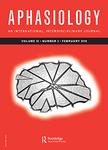版权所有:内蒙古大学图书馆 技术提供:维普资讯• 智图
内蒙古自治区呼和浩特市赛罕区大学西街235号 邮编: 010021

作者机构:City Univ London Div Language & Commun Sci London EC1V 0HB England Curtin Univ Sch Psychol & Speech Pathol Perth WA 6845 Australia
出 版 物:《APHASIOLOGY》 (失语症研究)
年 卷 期:2015年第29卷第7期
页 面:826-844页
核心收录:
学科分类:0502[文学-外国语言文学] 1002[医学-临床医学] 10[医学]
基 金:City University London Pump Priming Grant Dunhill Medical Trust [R171/0710]
主 题:aphasia discourse semantic weight procedural discourse iconic gesture
摘 要:Background: Conveying instructions is an everyday use of language, and gestures are likely to be a key feature of this. Although co-speech iconic gestures are tightly integrated with language, and people with aphasia (PWA) produce procedural discourses impaired at a linguistic level, no previous studies have investigated how PWA use co-speech iconic gestures in these contexts. Aims: This study investigated how PWA communicated meaning using gesture and language in procedural discourses, compared with neurologically healthy people (NHP). We aimed to identify the relative relationship of gesture and speech, in the context of impaired language, both overall and in individual events. Methods & Procedures: Twenty-nine PWA and 29 NHP produced two procedural discourses. The structure and semantic content of language of the whole discourses were analysed through predicate argument structure and spatial motor terms, and gestures were analysed for frequency and semantic form. Gesture and language were analysed in two key events, to determine the relative information presented in each modality. Outcomes & Results: PWA and NHP used similar frequencies and forms of gestures, although PWA used syntactically simpler language and fewer spatial words. This meant, overall, relatively more information was present in PWA gesture. This finding was also reflected in the key events, where PWA used gestures conveying rich semantic information alongside semantically impoverished language more often than NHP. Conclusions: PWA gestures, containing semantic information omitted from the concurrent speech, may help listeners with meaning when language is impaired. This finding indicates gesture should be included in clinical assessments of meaning-making.